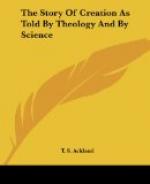We come now to the consideration of the first of Mr. Darwin’s supposed agencies—“Natural Selection,” or, “Survival of the fittest.” The results produced by this process must be ascribed to one of two causes: either they are the work of a Superintending Providence, watching over and directing every separate detail; or they are the result of pure chance and accident. There is nothing intermediate between these two causes. Natural law—apart from design and a designer—is, as we have seen, a nonentity—a mere expression of observed facts, for which it can give no account whatever. Mr. Darwin’s argument is expressly directed to exclude the interference of a superintending Providence. Chance is the only cause which he can bring forward. The very first question, then, which arises is, What is there upon which chance may operate? What are the conditions from which the probabilities may be calculated? Mr. Darwin assumes, and no doubt correctly, that minute variations are continually taking place. But as these variations are the result of accident [Footnote: If they are not the result of accident, we again see design and need a designer.] they will take place in various directions; some of them will have a beneficial, some of them a noxious tendency. As, moreover, they are supposed to be very small at each step, the difference of advantage in the case of different individuals must be also very small, and will not be likely to produce any considerable difference in the chances of pairing. But in order that any variation may be perpetuated and increased, the pairing of similarly affected individuals is necessary. Parents, in which the variations took opposite directions, would probably have offspring of the normal type, the opposite variations neutralizing each other. And this must be repeated again and again; and with every repetition of the process required, the probabilities against it would rapidly increase. Thus, supposing that in the first generation the proportion of favourable conditions were such, that of those animals that paired




